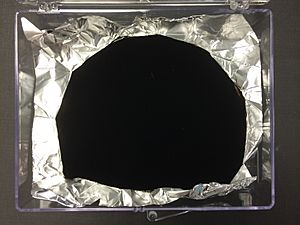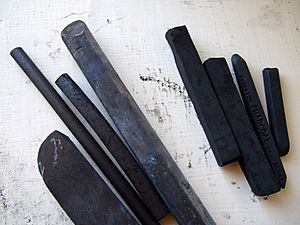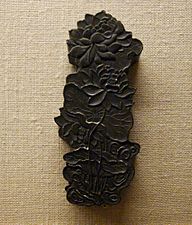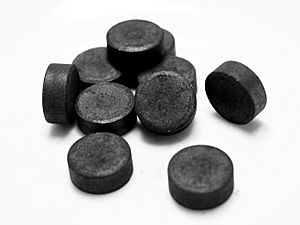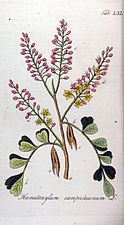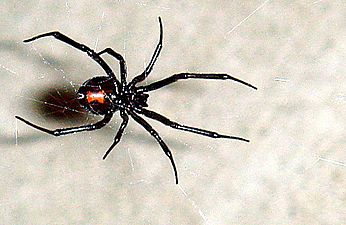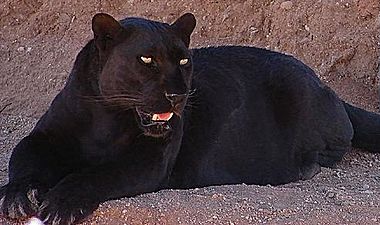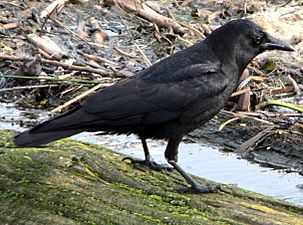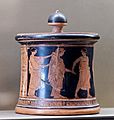Black facts for kids
| This box shows the color black. |
|---|
In light, black is lack of all color. In painting, however, the black pigment is the combination of all colors. In heraldry, black is called "sable".
Contents
Origin of black
The word black comes from Old English blæc ("black, dark", also, "ink"), from Proto-Germanic *blakkaz ("burned"), and from Proto-Indo-European *bhleg-. In many languages, black has the same meaning as ink.
Science
Physics
In the visible spectrum, black is the absorption of all colors.
Black can be defined as the visual impression experienced when no visible light reaches the eye. Pigments or dyes that absorb light rather than reflect it back to the eye "look black". A black pigment can, however, result from a combination of several pigments that collectively absorb all colors. If appropriate proportions of three primary pigments are mixed, the result reflects so little light as to be called "black".
This provides two superficially opposite but actually complementary descriptions of black. Black is the absorption of all colors of light, or an exhaustive combination of multiple colors of pigment. See also primary colors.
In physics, a black body is a perfect absorber of light, but, by a thermodynamic rule, it is also the best emitter. Thus, the best radiative cooling, out of sunlight, is by using black paint, though it is important that it be black (a nearly perfect absorber) in the infrared as well.
In elementary science, far ultraviolet light is called "black light" because, while itself unseen, it causes many minerals and other substances to fluoresce.
On January 16, 2008, researchers from Troy, New York's Rensselaer Polytechnic Institute announced the creation of the then darkest material on the planet. The material, which reflected only 0.045 percent of light, was created from carbon nanotubes stood on end. This is 1/30 of the light reflected by the current standard for blackness, and one third the light reflected by the previous record holder for darkest substance. As of February 2016, the current darkest material known is claimed to be Vantablack.
A material is said to be black if most incoming light is absorbed equally in the material. Light (electromagnetic radiation in the visible spectrum) interacts with the atoms and molecules, which causes the energy of the light to be converted into other forms of energy, usually heat. This means that black surfaces can act as thermal collectors, absorbing light and generating heat (see Solar thermal collector).
Absorption of light is contrasted by transmission, reflection and diffusion, where the light is only redirected, causing objects to appear transparent, reflective or white respectively.
-
Vantablack is made of carbon nanotubes and is the blackest substance known, absorbing a maximum of 99.965% of radiation in the visible spectrum.
Chemistry
Pigments
The earliest pigments used by Neolithic man were charcoal, red ocher and yellow ocher. The black lines of cave art were drawn with the tips of burnt torches made of a wood with resin.
Different civilizations burned different plants to produce their charcoal pigments. The Inuit of Alaska used wood charcoal mixed with the blood of seals to paint masks and wooden objects. The Polynesians burned coconuts to produce their pigment.
- Lamp black was used as a pigment for painting and frescoes. as a dye for fabrics, and in some societies for making tattoos. The 15th century Florentine painter Cennino Cennini described how it was made during the Renaissance: "... take a lamp full of linseed oil and fill the lamp with the oil and light the lamp. Then place it, lit, under a thoroughly clean pan and make sure that the flame from the lamp is two or three fingers from the bottom of the pan. The smoke that comes off the flame will hit the bottom of the pan and gather, becoming thick. Wait a bit. take the pan and brush this pigment (that is, this smoke) onto paper or into a pot with something. And it is not necessary to mull or grind it because it is a very fine pigment. Re-fill the lamp with the oil and put it under the pan like this several times and, in this way, make as much of it as is necessary." This same pigment was used by Indian artists to paint the Ajanta Caves, and as dye in ancient Japan.
- Ivory black, also known as bone char, was originally produced by burning ivory and mixing the resulting charcoal powder with oil. The color is still made today, but ordinary animal bones are substituted for ivory.
- Mars black is a black pigment made of synthetic iron oxides. It is commonly used in water-colors and oil painting. It takes its name from Mars, the god of war and patron of iron.
Dyes
Good-quality black dyes were not known until the middle of the 14th century. The most common early dyes were made from bark, roots or fruits of different trees; usually the walnut, chestnut, or certain oak trees. The blacks produced were often more gray, brown or bluish. The cloth had to be dyed several times to darken the color. One solution used by dyers was add to the dye some iron filings, rich in iron oxide, which gave a deeper black. Another was to first dye the fabric dark blue, and then to dye it black.
A much richer and deeper black dye was eventually found made from the Oak apple or gall-nut. The gall-nut is a small round tumor which grows on oak and other varieties of trees. They range in size from 2–5 cm, and are caused by chemicals injected by the larva of certain kinds of gall wasp in the family Cynipidae. The dye was very expensive; a great quantity of gall-nuts were needed for a very small amount of dye. The gall-nuts which made the best dye came from Poland, eastern Europe, the near east and North Africa. Beginning in about the 14th century, dye from gall-nuts was used for clothes of the kings and princes of Europe.
Another important source of natural black dyes from the 17th century onwards was the logwood tree, or Haematoxylum campechianum, which also produced reddish and bluish dyes. It is a species of flowering tree in the legume family, Fabaceae, that is native to southern Mexico and northern Central America. The modern nation of Belize grew from 17th century English logwood logging camps.
Since the mid-19th century, synthetic black dyes have largely replaced natural dyes. One of the important synthetic blacks is Nigrosin, a mixture of synthetic black dyes (CI 50415, Solvent black 5) made by heating a mixture of nitrobenzene, aniline and aniline hydrochloride in the presence of a copper or iron catalyst. Its main industrial uses are as a colorant for lacquers and varnishes and in marker-pen inks.
Inks
The first known inks were made by the Chinese, and date back to the 23rd century B.C. They used natural plant dyes and minerals such as graphite ground with water and applied with an ink brush. Early Chinese inks similar to the modern inkstick have been found dating to about 256 BC at the end of the Warring States period. They were produced from soot, usually produced by burning pine wood, mixed with animal glue. To make ink from an inkstick, the stick is continuously ground against an inkstone with a small quantity of water to produce a dark liquid which is then applied with an ink brush. Artists and calligraphists could vary the thickness of the resulting ink by reducing or increasing the intensity and time of ink grinding. These inks produced the delicate shading and subtle or dramatic effects of Chinese brush painting.
India ink (or Indian ink in British English) is a black ink once widely used for writing and printing and now more commonly used for drawing, especially when inking comic books and comic strips. The technique of making it probably came from China. India ink has been in use in India since at least the 4th century BC, where it was called masi. In India, the black color of the ink came from bone char, tar, pitch and other substances.
The Ancient Romans had a black writing ink they called atramentum librarium. Its name came from the Latin word atrare, which meant to make something black. (This was the same root as the English word atrocious.) It was usually made, like India ink, from soot, although one variety, called atramentum elephantinum, was made by burning the ivory of elephants.
Gall-nuts were also used for making fine black writing ink. Iron gall ink (also known as iron gall nut ink or oak gall ink) was a purple-black or brown-black ink made from iron salts and tannic acids from gall nut. It was the standard writing and drawing ink in Europe, from about the 12th century to the 19th century, and remained in use well into the 20th century.
-
The logwood tree from Central America produced dyes beginning in the 17th century. The nation of Belize began as a British colony producing logwood.
-
The industrial production of lamp black, made by producing, collecting and refining soot, in 1906.
Astronomy
- A black dwarf is a hypothetical stellar remnant, created when a white dwarf becomes sufficiently cool to no longer emit significant heat or light. Since the time required for a white dwarf to reach this state is calculated to be longer than the current age of the universe (13.8 billion years), no black dwarfs are thought to exist yet in the universe.
- A black hole is a region of spacetime where gravity prevents anything, including light, from escaping. The theory of general relativity predicts that a sufficiently compact mass will deform spacetime to form a black hole. Around a black hole there is a mathematically defined surface called an event horizon that marks the point of no return. It is called "black" because it absorbs all the light that hits the horizon, reflecting nothing, just like a perfect black body in thermodynamics. Black holes of stellar mass are expected to form when very massive stars collapse at the end of their life cycle. After a black hole has formed it can continue to grow by absorbing mass from its surroundings. By absorbing other stars and merging with other black holes, supermassive black holes of millions of solar masses may form. There is general consensus that supermassive black holes exist in the centers of most galaxies. Although a black hole itself is black, infalling material forms an accretion disk, which is one of brightest types of object in the universe.
- Black-body radiation refers to the radiation coming from a body at a given temperature where all incoming energy (light) is converted to heat.
- Black sky refers to the appearance of space as one emerges from Earth's atmosphere.
Why the night sky and space are black – Olbers' paradox
The fact that outer space is black is sometimes called Olbers' paradox. In theory, because the universe is full of stars, and is believed to be infinitely large, it would be expected that the light of an infinite number of stars would be enough to brilliantly light the whole universe all the time. However, the background color of outer space is black. This contradiction was first noted in 1823 by German astronomer Heinrich Wilhelm Matthias Olbers, who posed the question of why the night sky was black.
The current accepted answer is that, although the universe is infinitely large, it is not infinitely old. It is thought to be about 13.8 billion years old, so we can only see objects as far away as the distance light can travel in 13.8 billion years. Light from stars farther away has not reached Earth, and cannot contribute to making the sky bright. Furthermore, as the universe is expanding, many stars are moving away from Earth. As they move, the wavelength of their light becomes longer, through the Doppler effect, and shifts toward red, or even becomes invisible. As a result of these two phenomena, there is not enough starlight to make space anything but black.
The daytime sky on Earth is blue because light from the Sun strikes molecules in Earth's atmosphere scattering light in all directions. Blue light is scattered more than other colors, and reaches the eye in greater quantities, making the daytime sky appear blue. This is known as Rayleigh scattering.
The nighttime sky on Earth is black because the part of Earth experiencing night is facing away from the Sun, the light of the Sun is blocked by Earth itself, and there is no other bright nighttime source of light in the vicinity. Thus, there is not enough light to undergo Rayleigh scattering and make the sky blue. On the Moon, on the other hand, because there is no atmosphere to scatter the light, the sky is black both day and night. This phenomenon also holds true for other locations without an atmosphere.
Biology
-
The black mamba of Africa is one of the most venomous snakes, as well as the fastest-moving snake in the world. The only black part of the snake is the inside of the mouth, which it exposes in a threat display when alarmed.
-
The black widow spider, or lactrodectus, The females frequently eat their male partners after mating. The female's venom is at least three times more potent than that of the males, making a male's self-defense bite ineffective.
-
A black panther is actually a melanistic leopard or jaguar, the result of an excess of melanin in their skin caused by a recessive gene.
-
The American crow is one of the most intelligent of all animals.
Related pages
Images for kids
-
Megaloceros cave art at Lascaux
-
Modern-day monks of the Order of Saint Benedict in New Jersey
-
Statue of Anubis, guardian of the underworld, from the tomb of Tutankhamun.
-
Red-figure pottery with black background. Portrait of Thetis, about 470–480 BC. (The Louvre)
-
The Italian painter Duccio di Buoninsegna showed Christ expelling the Devil, shown covered with bristly black hair (1308–11).
-
Portrait of a monk of the Benedictine Order (1484)
-
Gutenberg Bible (1451–1452). Black ink was used for printing books, because it provided the greatest contrast with the white paper and was the clearest and easiest color to read.
-
Philip the Good in about 1450, by Rogier van der Weyden
-
Charles V, Holy Roman Emperor (1500–1558), by Titian
-
Portrait of Philip II of Spain (1527–1598)
-
Swiss theologian John Calvin denounced the bright colors worn by Roman Catholic priests, and colorful decoration of churches.
-
Increase Mather, an American Puritan clergyman (1688).
-
Rembrandt, Self-portrait (1659)
-
Arrangement in Grey and Black Number 1 (1871) by James McNeill Whistler better known as Whistler's Mother.
-
Berthe Morisot with a Bouquet of Violets, by Édouard Manet (1872).
-
Le Bal de l'Opera (1873) by Édouard Manet, shows the dominance of black in Parisian evening dress.
-
The Theater Box (1874) by Pierre-Auguste Renoir, captured the luminosity of black fabric in the light.
-
Wheat Field with Crows (1890), one of the last paintings of Vincent van Gogh, captures his agitated state of mind.
-
The Black Square (1915) by Kazimir Malevich is considered the first purely abstract painting (Tretyakov Gallery, Moscow).
-
The goth fashion model Lady Amaranth. Goth fashion was inspired by British Victorian mourning costumes.
-
The dowager Electress of Palatine in mourning (1717)
-
Emperor Pedro II of Brazil and his sisters wearing mourning clothes due to their father's death (1834)
-
Queen Victoria wore black in mourning for her husband Prince Albert (1899)
-
The biblical Four Horsemen of the Apocalypse, including famine riding a black horse (painting by Viktor Vasnetsov, 1887)
-
Count Dracula as portrayed by Bela Lugosi in the 1931 film version
-
The United States Supreme Court (2009)
-
Judges at the International Court of Justice in the Hague
-
A Black and white police car of the Los Angeles Police Department
-
A 1920 Ford Model T
-
The first model BlackBerry (2000)
-
Heroes in American westerns, like the Lone Ranger, traditionally wore a white hat, while the villains wore black hats.
-
The Duke of Windsor was the first to wear midnight blue rather than black evening dress, which looked blacker than black in artificial light.
-
French singer Edith Piaf always wore black on stage.
-
Country-western singer Johnny Cash called himself "the man in black." Image of his performance in Bremen, Northern Germany, in September 1972.
-
American violinist Joshua Bell wears black on stage.
See also
 In Spanish: Negro (color) para niños
In Spanish: Negro (color) para niños


